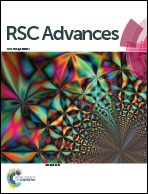Theoretical investigations on the phase transition of pure and Li-doped AlH3
Abstract
In order to solve a contradiction between early theoretical prediction and experiments concerning the γ → α phase transition of aluminum hydride, models of Li-doped AlH3 were constructed and investigated theoretically. Thermodynamic calculations show that the γ → α transition of pure AlH3 absorbs energy, and the changes in Gibbs free energy are in range of 1.74–1.99 kJ mol−1 at 298–380 K. These are opposite to the experimental fact that the γ- to α-phase transition takes place at 380 K. However, the changes in enthalpy and Gibbs free energy in the γ → α phase transition of Li-doped AlH3 are negative. The doping of Li decreases the activation energy of the γ → α transition and introduces more metastable states between them. As the doping content increases, both the changes in enthalpy and Gibbs free energy (ΔHγ→α and ΔGγ→α) decrease. The experimental ΔHγ→α value (−2.83 kJ mol−1) is between those of doped AlH3 with 1/23 and 1/11 Li-content (−0.87 and −5.62 kJ mol−1 for Al23LiH70 and Al11LiH34, respectively). Heat capacity CP(T) increases as the Li-doping content increases. The CP(T) of Al23LiH70 is consistent with the experiments. Considering the thermodynamic evidence and the experimental conditions for AlH3 preparation, the aluminum hydride synthesized by the reaction of LiAlH4 + AlCl3 is probably Li-doped with a Li content of 1/23. The changes in enthalpy and Gibbs free energy, as well as the activation energy for the γ → α phase transition can be increased if the Li-doped AlH3 is purified.



 Please wait while we load your content...
Please wait while we load your content...